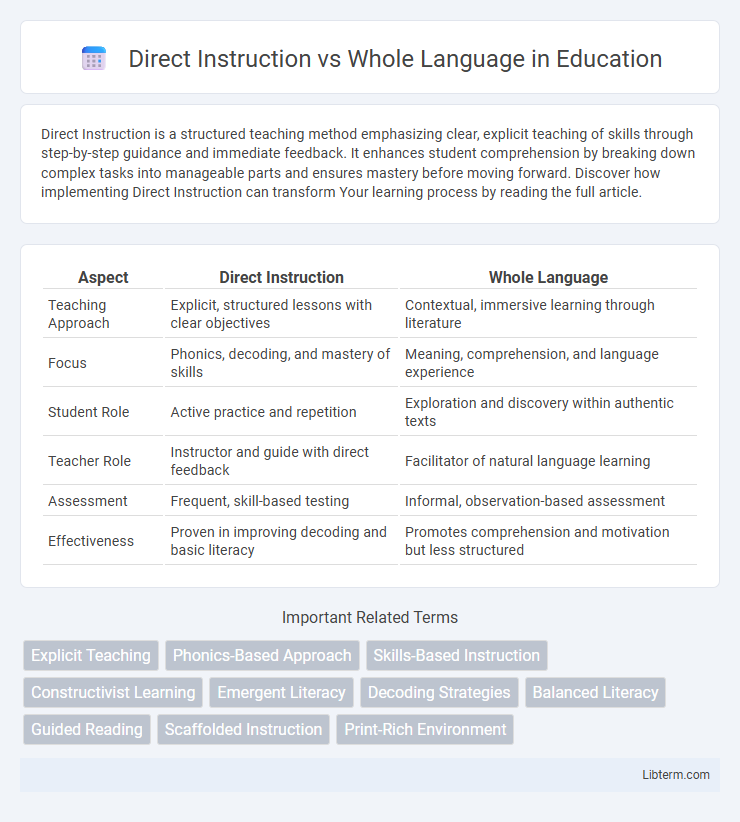Direct Instruction is a structured teaching method emphasizing clear, explicit teaching of skills through step-by-step guidance and immediate feedback. It enhances student comprehension by breaking down complex tasks into manageable parts and ensures mastery before moving forward. Discover how implementing Direct Instruction can transform Your learning process by reading the full article.
Table of Comparison
| Aspect | Direct Instruction | Whole Language |
|---|---|---|
| Teaching Approach | Explicit, structured lessons with clear objectives | Contextual, immersive learning through literature |
| Focus | Phonics, decoding, and mastery of skills | Meaning, comprehension, and language experience |
| Student Role | Active practice and repetition | Exploration and discovery within authentic texts |
| Teacher Role | Instructor and guide with direct feedback | Facilitator of natural language learning |
| Assessment | Frequent, skill-based testing | Informal, observation-based assessment |
| Effectiveness | Proven in improving decoding and basic literacy | Promotes comprehension and motivation but less structured |
Introduction to Direct Instruction and Whole Language
Direct Instruction emphasizes explicit, structured teaching with clear, scripted lessons designed to improve student outcomes through systematic phonics and skill mastery. Whole Language promotes immersive, context-rich language experiences that integrate reading, writing, and speaking, encouraging natural language acquisition through meaningful literature. Both approaches address literacy development but differ fundamentally in instructional methods and focus on either skills or holistic language use.
Historical Background of Both Approaches
Direct Instruction emerged in the 1960s as a structured, teacher-led method emphasizing explicit teaching of phonics and decoding skills, rooted in behavioral psychology principles. Whole Language developed in the 1980s as a response, promoting immersion in authentic texts and advocating that reading skills develop naturally through meaningful context. The historical debate reflects contrasting views on literacy acquisition, with Direct Instruction prioritizing systematic skill mastery and Whole Language emphasizing holistic language experiences.
Core Principles of Direct Instruction
Direct Instruction centers on explicit teaching techniques, emphasizing structured, scripted lessons to ensure clear and systematic skill development. Core principles include teacher-led instruction, guided practice, immediate feedback, and frequent assessment to reinforce learning and mastery. This approach contrasts with Whole Language, which prioritizes contextual and meaning-based learning over skill isolation.
Fundamental Tenets of Whole Language
Whole Language emphasizes the integration of reading, writing, speaking, and listening in meaningful contexts, promoting a holistic approach to literacy development. It relies on authentic literature and student-centered activities, supporting comprehension through natural language acquisition rather than isolated skill drills. Rich classroom environments encourage students to construct meaning collaboratively, fostering a love for reading and intrinsic motivation.
Teaching Methods: Direct Instruction vs Whole Language
Direct Instruction emphasizes explicit, structured teaching with scripted lessons and measurable objectives, promoting phonics and decoding skills systematically. Whole Language relies on immersive, meaning-based learning where students engage with authentic texts and develop literacy through context and comprehension. Research indicates that Direct Instruction often yields stronger outcomes in early reading proficiency, while Whole Language supports holistic language development but may require supplemental phonics support.
Effectiveness in Literacy Development
Direct Instruction emphasizes explicit teaching of phonics and decoding skills, resulting in faster literacy acquisition and higher reading proficiency, especially for struggling readers. Whole Language promotes contextual learning and immersion in meaningful texts, enhancing comprehension and motivation but often leading to inconsistent decoding abilities. Research consistently shows Direct Instruction yields more reliable improvements in early literacy development, particularly in phonemic awareness and decoding accuracy.
Classroom Implementation Strategies
Direct Instruction emphasizes explicit teaching techniques with scripted lessons, frequent assessments, and immediate corrective feedback to ensure mastery of phonics and decoding skills. Whole Language implementation prioritizes meaningful reading experiences, integrating literature, student choice, and contextualized learning to enhance comprehension and engagement. Effective classrooms often blend structured skill development from Direct Instruction with the immersive, authentic literacy practices of Whole Language.
Research Findings and Case Studies
Research findings reveal that Direct Instruction consistently improves phonemic awareness and reading fluency through explicit, systematic teaching methods, as demonstrated in multiple controlled studies. Case studies show schools implementing Whole Language approaches often experience initial engagement but face challenges in achieving long-term literacy proficiency without supplemental phonics instruction. Meta-analyses indicate that integrated methodologies combining Direct Instruction and Whole Language components yield higher literacy outcomes, emphasizing the significance of balanced reading instruction frameworks.
Advantages and Limitations of Each Approach
Direct Instruction offers clear, structured lessons with explicit teaching of skills, promoting rapid acquisition of foundational literacy, yet it may limit opportunities for creativity and student-led exploration. Whole Language emphasizes immersion in rich, meaningful texts to develop comprehension and a love for reading but can result in slower mastery of phonics and decoding skills. Each approach balances skill development and engagement differently, affecting diverse learner needs and instructional contexts.
Choosing the Right Approach for Different Learners
Direct Instruction emphasizes structured, explicit teaching methods ideal for learners needing clear guidance and skill mastery, while Whole Language promotes immersion in authentic reading experiences, benefiting those who thrive in context-rich environments. Selecting the right approach depends on individual learner needs, with assessments guiding whether systematic phonics or holistic literacy practices will enhance reading development. Combining elements from both methods often yields the most effective outcomes by addressing diverse cognitive and motivational profiles.
Direct Instruction Infographic

 libterm.com
libterm.com